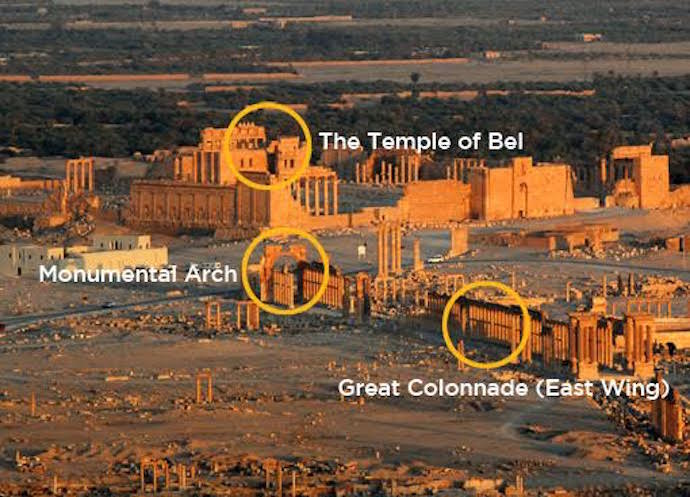What is known as the arch of “triumph” has set London ablaze, and is ready to make an appearance in New York this September. The ‘Arch’ of Triumph has a well known history, being that it is the “entrance” way to the temple of Baal in Palmyra Syria.
On September 19th, 2016 the Institute for Digital Archeology will bring the Arch of Palmyra replica to New York City, in a yet to be determined location in Manhattan. The arch of Palmyra replica was already installed in London back in April 2016.

Originally the plan was to construct a replica of the temple of baal in both New York and London, but after massive amounts of uproar from the people – UNESCO and the Institute for Digital Archeology announced that they would not reconstruct the temple of baal but rather they would rebuild the arch of Palmyra.
The Arch of Palmyra, or also known as the Arch of Triumph is essentially the entranceway to the temple of baal. “The Monumental Arch was built sometime during the reign of emperor Septimius Severus, which lasted from 193 to 211 AD; it linked the main street of the Colonnade and the Temple of Bel.” Bel and Baal are the same deities. Both are represented in the Bible as the enemy of the Sovereign God, the Living God, the God of the Bible better known as Yahweh.
Who is baal?
According to Canaanite mythology, Baal was the son of El, the chief god, and Asherah, the goddess of the sea. Baal was considered the most powerful of all gods, eclipsing El, who was seen as rather weak and ineffective. In various battles Baal defeated Yamm, the god of the sea, and Mot, the god of death and the underworld. Baal’s sisters/consorts were Ashtoreth, a fertility goddess associated with the stars, and Anath, a goddess of love and war. The Canaanites worshiped Baal as the sun god and as the storm god—he is usually depicted holding a lightning bolt—who defeated enemies and produced crops. They also worshiped him as a fertility god who provided children. Baal worship was rooted in sensuality and involved ritualistic prostitution in the temples. At times, appeasing Baal required human sacrifice, usually the firstborn of the one making the sacrifice (Jeremiah 19:5). The priests of Baal appealed to their god in rites of wild abandon which included loud, ecstatic cries and self-inflicted injury (1 Kings 18:28).
Before the Hebrews entered the Promised Land, the Lord God warned against worshiping Canaan’s gods (Deuteronomy 6:14-15), but Israel turned to idolatry anyway. During the reign of Ahab and Jezebel, at the height of Baal worship in Israel, God directly confronted the paganism through His prophet Elijah. First, God showed that He, not Baal, controlled the rain by sending a drought lasting three-and-one-half years (1 Kings 17:1). Then Elijah called for a showdown on Mt. Carmel to prove once and for all who the true God was. All day long, 450 prophets of Baal called on their god to send fire from heaven—surely an easy task for a god associated with lightning bolts—but “there was no response, no one answered, no one paid attention” (1 Kings 18:29). After Baal’s prophets gave up, Elijah prayed a simple prayer, and God answered immediately with fire from heaven. The evidence was overwhelming, and the people “fell prostrate and cried, ‘The LORD–he is God! The LORD–he is God!’” (verse 39).
In Matthew 12:27, Jesus calls Satan “Beelzebub,” linking the devil to Baal-Zebub, a Philistine deity (2 Kings 1:2). The Baalim of the Old Testament were nothing more than demons masquerading as gods, and all idolatry is ultimately devil-worship (1 Corinthians 10:20). –Got Questions
Interestingly enough, Baal happens to house the same symbolism as Zeus, the Greek deity.
However, the archway is the entranceway; so essentially the temple’s entrance way will be being reconstructed in New York in September. Exactly where it will stand in New York is a mystery, but here’s a clue: “The arch will stand in Manhattan, surrounded by buildings adorned with classical features suggesting the common cultural roots of East and West.”
The message portrayed with the reconstruction of such a demonic temple is as follows; “Every time we resurrect from the rubble one of these monuments, it undercuts the message of fear and ignorance that these people are trying to spread,” he said. “If they knock it down, we will rebuild it. If they knock it down again, we will rebuild it again.”
The interesting part of it all. One of the names for the entranceway is “the Arch of Septimius Severus.” Whose name happens to mean seven, and whose name also practically means the month of September. See more below:
https://www.youtube.com/watch?v=UrV37b5-KVQ
Share your thoughts below!
Works Cited
michelle young. “ Replica of Lost Palmyra Arch Will Be in NYC in September .” Untapped Cities. . (2016): . . http://untappedcities.com/2016/08/16/replica-of-lost-palmyra-arch-will-be-in-nyc-in-september/


our walls have been broken (book of Nehemiah) pray for the nation
Break it down repeatedly,or God will!
Anytime they rebuild it, knock the phucker down AGAIN, and AGAIN, and AGAIN throughout eternity! Then, KNOCK IT DOWN AGAIN!
Totally agree!!
It should never stand on these shores!
Unbelievable
Type in 23 September click the United kingdom address in Google maps…. Shocker…. Look what is written on the van in front of the address? Whaaaat
This nation !!!!! Must stand for the one true living GOD. We Must!!!
OR it shall be destroyed, GOD is not marked. Tear the baal temples down.